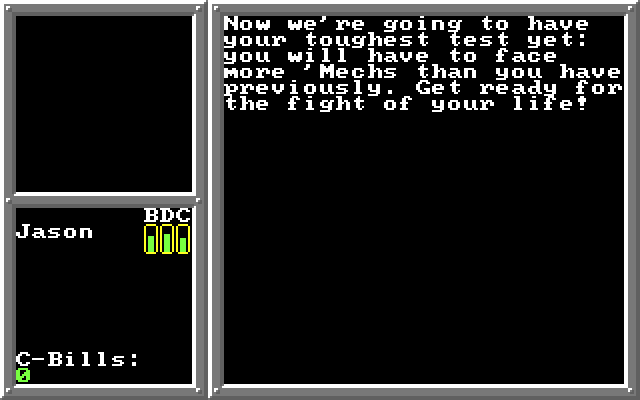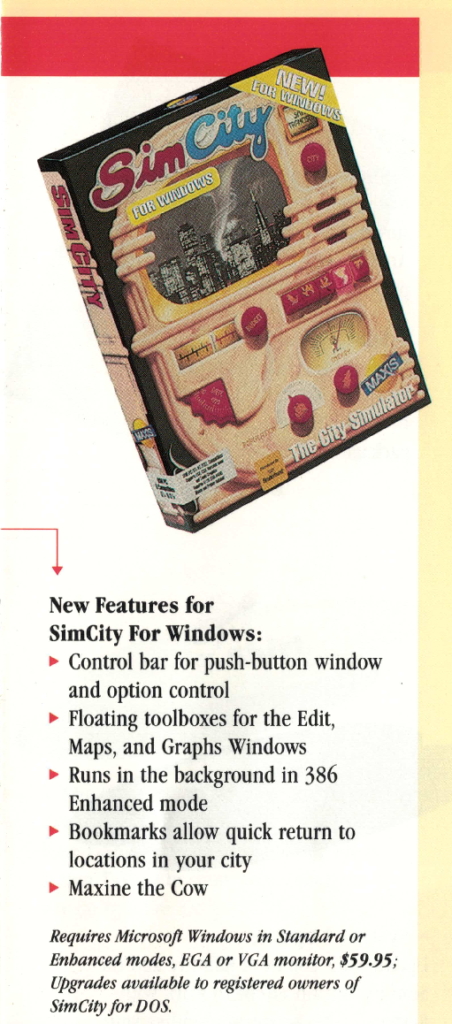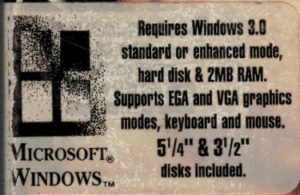
For the next 38 hours GOG is giving away Shadow Warrior 2 for free!
Go to https://www.gog.com/#giveaway and get your free copy today!


For the next 38 hours GOG is giving away Shadow Warrior 2 for free!
Go to https://www.gog.com/#giveaway and get your free copy today!
Continuing in my eventual goal to get all the Maxis games (Sim City, Sim Earth) for Windows 3.0 I just acquired Sim Life.
Although the box that I have is the ‘Classics’ version, it actually does support Windows 3.0 as specified on the box. The requirements were again massive for the era, but pitiful for today requiring an 80386 processor, and 4MB of RAM, and a VGA display!
Unlike Sim City, the UI in Sim Life prevents you from moving MID child windows under the title bar, making playing on modern machines much more tolerable. My copy arrived with 3 low density 3 1/2″ diskettes, and a 204 page manual, making for a very hefty learning curve, along with a more involved experience then something casual, say Spore.
There is no doubt about how there is a great deal of overlap between Sim Earth and Sim Life, although the timescale is certainly more geared to life, unlike Sim Earth’s geological timescale, and even with these 3 programs it certainly feels like the save files should have been able to be transfered at some point, that the genesis of Spore is here with moving from geological to biological then to human lifetime scales. Although with so many things to change and get involved in, I really have to wonder if dumbing down Spore was the ‘right thing’ to do, to make it more accessible, however there is no doubt that the space portion of Spore was terrible with only a single ship to command, which made growing an empire of any size once the Grox has been encountered impossible.
Having a modern display does make the sense of the planet feel laughably small, but it’s a game, not a real life simulation, and as such expected to execute on 16Mhz machines. That said running on Crossover (Wine) on my Xeon it is incredibly snappy. One nice touch is that Sim Life is able to detect sound properly and it’ll run silently on Windows 3.0, but with 3.1 with configured audio & MIDI drivers, it’ll play (annoying) sounds, and the occasional MIDI track.
The included catalogue for this game didn’t have any prices so I don’t know what the retail price was at the time. And I have to admit, short of collecting old games for Windows 3.0 there is probably little value here compared to the far more relatable Sim City for Windows.
Also it just goes to say that although it scales nicer for the UI on a VGA display, comparing my Apple Cinema display to VGA really makes for a claustrophobic experience.
Unless you are a diehard fan, I’d say that you’d get more out of the much flawed spore. Although if you want to see how incredibly more detailed the older games were, you’ll certainly love this one!
What is this, an arcade for ants?
I saw these at a local Toys R Us, and picked a few up. They were selling for $200 HKD which is about $25 USD. They are SUPER tiny, and yet very cool to actually play with. They feature a single game on each cab, and luckily there is no coin slot, just a player 1 button.  As a bonus the marque does light up, which is why I wanted to do a dark/night picture of the machine.
The games have been modified for what I’d assume is an ARM SOC, and game play is somewhat easier. For anyone looking for the exact arcade expedience, they will be no doubt disappointed as many things like sprite animations are simply lacking in this version.
That said the controls are surprisingly very responsive, and it’s almost a treat to play, except of course that the screen is so incredibly small, the sound is faint, and it’s not hard to have your thumb in the way obscuring things.
It’s a neat novelty item, but it’s no substitute for a nice USB arcade stick & a copy of MAME, or the actual PCB & a JAMMA harness.
While stumbling around, I found Open Quartz, which is to Quake as FreeDooM is to DooM, or for those who don’t know it is free assets allowing a fully redistributed game. Although the bundled levels are actually kind of reminiscent of Q3 Arena, one of the great abilities of Quake 1 was inline total game conversions like Team Fortress. Yes it started as a Quake mod.
So I downloaded the Open Quartz binary pak’s and went to do a quick comparison of the two:
I should do an update for QWDOS to allow multiple clients at once for OS’s that’ll support multitasking (Windows) where you can bind the client to different ports to allow more than one to work at a time. The line is:
NET_Init (PORT_CLIENT);
Although I guess the next best thing is to change the NET_Init code to start with the default port as a base, and if it can’t bind to it, then just increment until you get a winner.
And yes, that is the Quake World for MS-DOS port running on Windows. I built it with Visual C++ 5.0, although using a newer linker that I pulled from masm32.com, which would work with the newer libs, well all except the ogg vorbis stuff, so I just disabled it, as I just wanted to test, and didn’t care too much about music.
So I guess the next thing to do is bundle it all together into something more convenient to the end user.
The laptop I’m using at the moment is old, Alienware 14 P39G that is 5 years old. The power is convinced that it can’t run over 700Mhz unless it’s on battery for some reason, then it’ll jump to 2.3Ghz just fine. Oh well It’s otherwise not bad, just getting old.
Also it’s only using the Intel GPU. I think I need to do a fresh install of the 2018 version of Windows 10 on this thing.
Anyways so CXBX Reloaded can run many xbe’s directly so you don’t need a ROM or dashboard, but it’ll run the dashboard if you have it. It’s really cool though as JSRF did come to Android but it won’t run on any modern versions of Android. As far as I know it never came to PC, but being able to run the X Box version is certainly cool.
Sourcecode & nightly binary builds are currently on github:
https://github.com/Cxbx-Reloaded/Cxbx-Reloaded/
I was able to find Jet Set Radio Future (JPN Demo).7z, which I think is a playable demo, although I don’t have any controllers to test it. But it certainly loads up just fine!
Also here is a very poorly captured video of JSRF on CXBX, You can see the laptop struggle on the main power, then able to run at 60fps on battery power…
Now that I have awesome animated GIF technology I can show off one of the greatest things to do in the 1988 BattleTech game, escaping the initial Kurita invasion with a battle mech. While you can try to beat the 3-4 Jenners, and maybe win, it’s far far far easier to just make a dash for it.
So basically all you have to do is run south, then head west, don’t engage, just jump over rough terrain, and run! Once outside the wall, you can flee.
 Meanwhile back in 2018, people are crying that the new BattleTech is some how stacked, and the AI just cheats. But the mechanics are pretty darned close to the real table top game, except that if you have been pushed down, you can not only get up on your next turn, but run around and fire. Grrr… The story in 2018 is just as laughably bad as it was in 1988, but honestly I didn’t come here for Shakespear, I wanted to see giant robots fight! I know for many the idea of the table top game is … well outside of what people know, and the idea that you are standing in front of something with a 98% chance to hit, and you not only miss, but manage to explode while doing so is just a slice of life that is the hell that is table top gaming.
Meanwhile back in 2018, people are crying that the new BattleTech is some how stacked, and the AI just cheats. But the mechanics are pretty darned close to the real table top game, except that if you have been pushed down, you can not only get up on your next turn, but run around and fire. Grrr… The story in 2018 is just as laughably bad as it was in 1988, but honestly I didn’t come here for Shakespear, I wanted to see giant robots fight! I know for many the idea of the table top game is … well outside of what people know, and the idea that you are standing in front of something with a 98% chance to hit, and you not only miss, but manage to explode while doing so is just a slice of life that is the hell that is table top gaming.
And for those who think the new game is rather ‘un-fair’, Just after I stole the Chameleon, guess what happened?
 That’s right, a Locust of all things got off a lucky shot to my weak back, and destroyed my mech, and the next shot with a machine gun, killed me as I tried to flee. How is that for fair?
That’s right, a Locust of all things got off a lucky shot to my weak back, and destroyed my mech, and the next shot with a machine gun, killed me as I tried to flee. How is that for fair?
BattleTech has always been like this.
So yeah, Kids need to GTFO my lawn.
It’s the ‘classic’ MacOS. And it requires Code Warrior 10 to build. Apparently its for the PowerPC only, although I haven’t tried to compile it yet, as I foolishly just upgraded to 10.5 on my PowerPC, which of course has no classic support.
Source code is on github, here.
It’s a nice present from Night Dive studios. I know that many people are mad at their reboot being consumed by feature bloat, but at least they aren’t going down into obscurity.
As always, enjoy!
Links 386 is one of those programs that is very easy to love to hate. It was 1992, and PC’s were mostly being used for business, and high powered 32-bit machines were still insanely expensive. And then Links 386 happened. Before there was DooM, Links 386 was the ‘must have’ executive ball clacking device. And the specs that you needed to run this game were really over the top. At it’s heart was the Phar Lap 386 Dos extender, along with the virtual memory module.. Which most people would have to rely on. Links 386 really needs over 8MB of RAM to run. Yes, that is correct, in 1992 you were recommended to get 8MB (which should have been about $400-800 USD) So you can golf at your desk. But as the name implies you also needed a 386 classed computer, although ideally you would have one of those new 486’s! Links 386 also pushed the edge by wanting a VESA capable SVGA card that could use mode 101, 103, or 105. Although the higher resolutions modes just ended up with logos everywhere, it really didn’t take enough advantage of the higher resolution modes.
Another interesting thing is not only does Links 386 have sound drivers (which means you need a sound card!) but it’ll do voice through the AdLib card. Also it has a driver model, the WLZ, which I don’t know if they ever published or if people wrote additional sound drivers.
The installer is kind of cute, in that it’s flat shading is so old it’s now modern. How’s that for crazy?
Installation is a snap, at only four diskettes. They sold additional courses, and I only have one additional course, although oddly enough finding others online is pretty trivial. However I had far less luck finding the program. One nice tip to Infocom is that the courses include a score card, like the ones you would get on actual courses. It really tied the package together.
Although for me, I really bought it for the manual.
And I have to admit it, Access Software did a great job. Even all these years later, it looks great. But no doubt scaling and placing all the textures is SLOW. Incredibly slow.
Back in the 90’s I had a lowly support job, and I’d get flown all over the country to help out with issues, and it’d never fail that the regional director would have ‘issues at home’ and amazingly they’d always ask about running Links 386 Pro. No doubt a lot of people upgraded machines, and got to brag to their buddies on how fast Links would now load. Running at actual 386 speeds will take nearly a minute to render the screen between shots.
The DOS Extender was forever very touchy. It took a bit of work to get around it’s issues, with the continuous conflicts with TSR’s, drivers, sound cards, video cards.. It was a nightmare of compatibility issues. Not to mention that although Phar Lap 4.1 was DPMI compatible, it really didn’t play that nice with OS/2 or Windows. Microsoft would later come to the rescue for this costed gamer market in the form of buying Links away from Access software, and putting out Microsoft Golf. And much like SimCity, being able to run this under Windows make it immensely popular in the workplace, as all you needed to find were Windows drivers for your hardware, which vendors did actually support, unlike games.
It’s amazing how companies like Phar Lap, or Rational never did try to make an actual gaming platform for their extenders, leaving it all up to individuals. My older self says that Microsoft’s rise to prominence in the 90’s was mostly due to their competitors incompetence, rather than their brilliance.
Although DOS Extenders like Phar Lap have been around since the introduction of the 80386, Links 386 Pro is the oldest one I know of. If you like programs that try their best to bend the limits of what you can or should do, certainly check out Links 386 Pro!
Well the results were predictable.
Earthquake destroyed everything.
I know it’s about as interesting as watching security footage, but I was testing if I could actually ‘broadcast’ an application. In this case, SimCity for Windows 3.0 on Citrix 2.0 in PCem. I’ll have to mess with Virtual Audio Cables, to rig something to get audio working.
In this case, I’m looking at the ultra-popular Sim series, and their Windows releases. While I was a big fan of SimCity, especially having played it on an Amiga, when I found out that there was a Commodore 64 version, I had bought it immediately as I wanted to play it at home. And let me tell you, it was a severely underwhelming experience.
From the logo it’s all down hill. I know that SimCity is actually from 1985, and as the first version, the Commodore 64 version is basically the prototype.
Which was just graphically underwhelming, but I still played the hell out of it. And then I saw the Spectrum 48k version. Yes, the blocks are ‘buildings’ as the units fill up, they will turn into black with only the letter remaining. Despite the ultra-minimal graphics, the game play is there. And once you get used to the bizarre combination keyboard+joystick controls it is addictive. I mean it is SimCity!
But going to the PC, I kind of grew out of SimCity. DooM was the hot game, and the whole immersive 3d thing. And of course during that era being on the PC I only knew of the MS-DOS version. While there was a version for OS/2 Warp released much much later, and by then if I felt the urge there was SimCity 2000 for Windows.
But after getting the kick for SimEarth, and finding the Windows 3.0 version, I was much surprised to find out that there was a version of SimCity of Windows 3.0 as well!
And I can see why I never had seen this for retail, or knew anyone who had it.
 That’s right in the included form, the price was $59.95. And SimEarth was $69.95! To put that in perspective that would be now $107.17, and $125.04 respectively. And people think $60 for a game today is expensive!
That’s right in the included form, the price was $59.95. And SimEarth was $69.95! To put that in perspective that would be now $107.17, and $125.04 respectively. And people think $60 for a game today is expensive!
To get the full experience I went ahead and loaded up PCem, with a 386 and EGA graphics to get that original feel.
Since this requires Windows 3.0, with either EGA or VGA graphics, and 2MB of RAM, I figured I would go with a ‘top of the line’ souped up 386DX. I tried to load it up with the Wyse700 driver, and the game fails to load resources. I don’t know if its even possible to make black and white or four colour resources, as I live in the future, and I have millions of colours!
That said, I tested and it has no issues with 8bit depths either.
Installation is pretty smooth, the game is shipped on either two 360k 5 1/4″ diskettes, or a single 720kb diskette. While modern games have so much more, there is many things this game is lacking. But Maxine isn’t one of them.
No really, she is listed as a feature.
The music is through the PC speaker. Just like the sound effects. Multimedia integration with Windows that we take for granted today just wasn’t a thing back then. The version I have is 1.0, Although a pirated version 1.1 that was sent in actually includes WAV sound effects, and a single midi track. However it doesn’t run on Windows 3.0. So lucky me!
Ah the UAE, the bane of Windows 3.0. They were so unpopular that Microsoft had to rename the dialog.
Living in the constraints of EGA feel absolutely claustrophobic in today’s world. 640×350 just isn’t enough screen rel estate. Even 640×480 is far far too small. And that lead to one issue I found
While using a SVGA driver so I can get that impossible to afford experience of 1280×1024 in 256 colours, but the application was never meant to run in something that wide. You can easily put child windows ‘behind’ the dead space, and you can never recover them. You have to save and re-launch. bummer.
Which leads me to perhaps the most famous reputation of SimCity for Windows. As mentioned on Joe’s site, there was a massive struggle to get games like SimCity running on Windows 95. As Raymond Chen says:
If any application failed to run on Windows 95, I took it as a personal failure. I spent many sleepless nights fixing bugs in third-party programs just so they could keep running on Windows 95. (Games were the worst. Often the game vendor didn’t even care that their program didn’t run on Windows 95!)
Yes, they basically knew it had problems. In the box they even had this cute flyer:
And yes, rest assured it actually does work. It even works on Windows 3.00a under Citrix MULTIUSER 2.0 Pointless as there is no way to have remote graphical displays but nice to see it work.
 So what went wrong? Where was all the follow up games for Windows? Obviously, the hardware needed was incredibly expensive. A 386 or even a 286 with a few megabytes of RAM was expensive. VGA or EGA monitors were also very expensive. Even mice were expensive! Putting together a low end PC basically barred you from this high end premier experience. I can’t imagine that Maxis sold many copies of this. As mentioned above I’m pretty sure there is a reason why I never saw this in the wild.
So what went wrong? Where was all the follow up games for Windows? Obviously, the hardware needed was incredibly expensive. A 386 or even a 286 with a few megabytes of RAM was expensive. VGA or EGA monitors were also very expensive. Even mice were expensive! Putting together a low end PC basically barred you from this high end premier experience. I can’t imagine that Maxis sold many copies of this. As mentioned above I’m pretty sure there is a reason why I never saw this in the wild.
Spending $3000 in early 1992, which is $5197.95 in today’s money. I can’t even begin to imagine spending over $5,000 to play a game. It’s no wonder when older machines show up on eBay people want far too much for them.
In a strange way I like to watch SimCity animate in the background. It’s like a fish tank or staring out into a busy street. With the advantage that I can summon a giant lizard to destroy it at my whim.